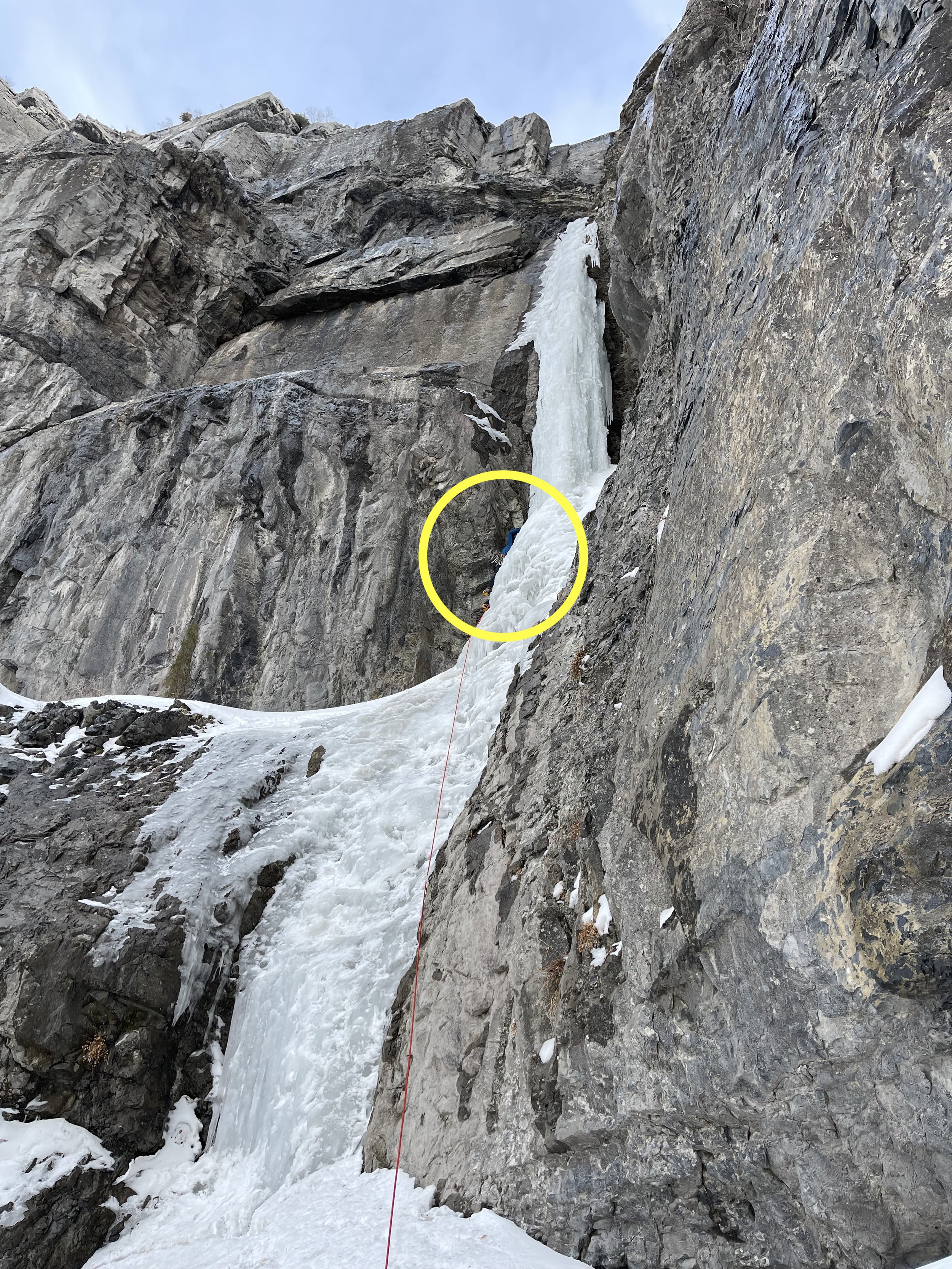Ice is a fickle medium that is hard to assess. This month we’re highlighting an accident report from ANAC 2023 involving a leader fall that was compounded by pulled protection. Though the climber was very experienced, this accident underlines that even as more people climb ice than ever before, it takes years of experience to accurately gauge conditions. Also, climate change is increasing the hazards of rockfall, avalanches, ice collapse, and generally warmer ice.
Tim Thompson (circled in yellow) climbing on the Finger of Fate prior to his accident. The gray, bubbly, and unbonded ice in the lower section of the photo reflects the warm temperatures on the day prior. Dustin Lyons
Fall on Ice | Protection Pulled Out
Provo Canyon, Upper Provo Falls
Utah County Sheriff’s Search and Rescue was dispatched at 11:09 a.m. on December 26 to aid an ice climber who had fallen from the first pitch of Finger of Fate (3 pitches, WI4+) in Provo Canyon.
The climber, Tim Thompson (29), was nearing the end of the first pitch when ice sheared from under his left foot. He wrote to ANAC that he was “pushed forward into my ice tools and my relaxed grip caused me to fall.” Thompson’s uppermost screw pulled out of the ice, causing him to fall a total of 50 feet.
Utah County team members arrived and, with the help of the climbers already on scene, evaluated the ice conditions, established an equalized anchor with six screws at the base of the climb, and developed a plan to move the patient horizontally about 100 feet over steep, slippery terrain to a five-by-ten-foot ledge that was out of the rockfall and icefall area. Conditions were deteriorating, the ice was becoming less cohesive as temperatures rose, and rocks were starting to fall.
A Department of Public Safety (DPS) helicopter crew did a reconnaissance of the ledge and determined that it would be a suitable place for a hoist operation. The patient was then short-hauled from the ledge to a nearby parking lot, where an ambulance was waiting. He was airlifted to a hospital and assessed to have two broken vertebrae, a broken elbow, torn ligaments in an elbow, and a badly broken left wrist.
Tim Thompson after falling from the first pitch of Finger of Fate. Rescuers short-hauled him by helicopter to a waiting ambulance. Photo: Dustin Lyons.
ANALYSIS
Warm conditions make ice climbing hazardous. Recalls Thompson: “The weather was warm the day before. Temps overnight were about 28°F for almost 10 or 12 hours and were hovering around 31°F or 32°F while climbing. We felt confident that the ice had had enough time to heal, and that as long as we climbed quickly, we were in no danger.”
Running water, heat retained by the underlying rock, and even indirect solar radiation can prevent ice from refreezing. The warm temperatures also affected the quality of Thompson’s protection. He wrote to ANAC, “When I put in the last ice screw, the ice was really soft. Up until the last quarter of the route, the ice [had been] really healthy and the screw placements were really good. I got several really solid screws lower on the route, and the second-to-last one (the one that caught me) was in really bomber ice.”
Thompson did well to place extra gear that he might have dismissed as unnecessary. Before the final section of the pitch, he says, “I remember pulling onto the ice after a ledge rest and deciding to step back down and place a high screw. I knew that would be a lot of protection, as the last screw was just below my feet. But if I had not placed this screw, I would have hit the deck from almost 100 feet up. Things could have been a lot worse.”
Sources: Salt Lake County Sheriff’s Search and Rescue and Tim Thompson.
The Prescription—Video Series
Warm conditions make ice climbing hazardous. Pete Takeda, editor of Accidents in North American Climbing, and IMGA/AMGA Guide Jason Antin are back to explain the hazards ice climbers face in warm conditions, such as protection pulling, poor tool placements, and shearing crampons.
Producers: Shane Johnson and Sierra McGivney; Videographer: Foster Denney; Editor: Sierra McGivney
Location: Silver Plume Falls, Silver Plume, CO
A NOTE FROM THE EDITOR
Over time an ice climber learns to gauge conditions and most importantly, when to go for it and when to back off. This is a long and experience-based learning curve. The biggest lesson is: If it doesn’t feel right, don’t do it. Whether a novice or an experienced ice climber, don’t factor luck into your decision-making.
Utah guide Derek DeBruin’s flowchart is a handy tool to assess ice climbing decision-making on any given day:
This flowchart can assist in managing hazards by helping determine the stability of the ice, the effectiveness of ice screw protection, and the quality of ice tool placements. Downloadable versions are available here.
Presented By:
Support This Work— Join or Give Today
Your contribution will significantly impact climbers—whether they are learning how to avoid accidents through our updated database, using research funding to analyze melting ice caps and the changing heights of iconic mountains, or pursuing first ascents around the world. Your gift makes these things possible.







